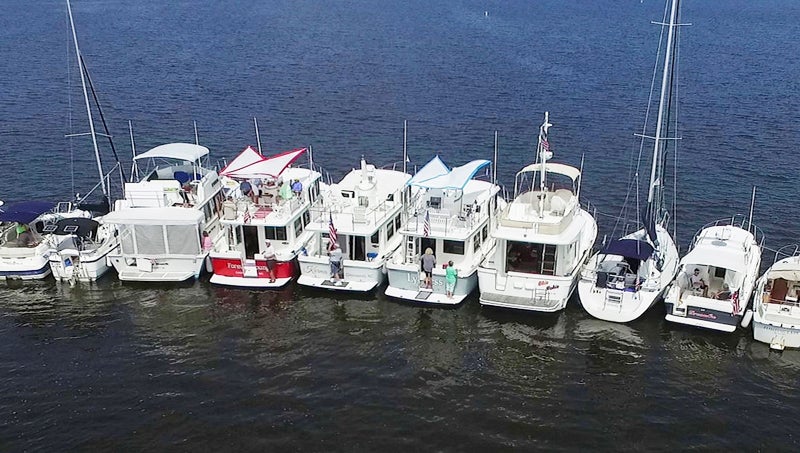Summer on the water and rafting up
Published 2:56 pm Friday, August 18, 2017

- (PSPS)
A raft-up is a gathering of boats, usually a social event built around boaters on their boats. I believe the world record raft-up was more than 200 boats though ours here are more like five to 20 boats. Summer days are perfect for a gathering of boaters.
Also in a raft-up, in this case, is a process, a structure to protect life, limb and fiberglass. When participating in a raft-up, you should come prepared with extra fenders and lines, plus food and beverage to share. You’ll need the fenders and lines to protect each other’s boat in addition to people. Hint: mark your lines and fenders in advance, enabling you to identify yours when breaking apart a raft-up.
Rule of thumb, larger boats rafting in the center create the base with one or more anchors with ample anchor rope. Boats become progressively smaller on both sides of the center or anchor boat.
Communication is critically important. Communicate your intentions when entering the raft-up to the anchored boat and to the boat to which you will be tying up. Anchors by other boats cause lines to become entangled as boats join or leave the group. Depending on the strength of current and wind, having a medium-sized boat anchored on the ends holds the raft-up steady.
Typical raft-ups are straight across, bow to the current or wind. A stern-to-stern raft-up is safer for people moving from boat to boat. Sterns will be at about the same height plus the stern or swim platform is flat and designed for traction as visiting across the boats occur. Climbing across slanted bows and over rails is dangerous.
Another option is one group, usually larger boats bow to the current or wind with another group, smaller boat stern in with the larger boats. A third option is a circle that may expand or contract, as needed with most every boat having an anchor out.
Regardless of the option used, the same logic applies as with any docking. Be sure of your plan, communicate it to your crew and the boat you are rafting to. Also, be prepared with fenders and lines out and tied. Be sure to have extra lines, especially spring lines at the ready. Also like when docking, slow and easy does it.
Deploy ample fenders where boats might touch. In straight raft-ups, join boats at the widest part of the bow with ample fenders. Tie each boat tightly to the adjacent boats to prevent them hitting in a wake, waves or wind. Caution: people have lost limbs, even their lives, when they fell between boats that then come together. Boats should not move or bang together in a well-constructed, tight raft-up.
Boating etiquette mandates boating shoes only, plastic, no glass and nothing out of the ordinary such as loud music. A boat is someone’s house, so ask permission before crossing boats. Enjoy the shared food and refreshment.
When a boat anywhere in the raft-up wants to leave, simply reverse the process of bringing that boat into the group. Untie the boat, keeping the fenders in place, then manually walk the boat out of the group. Have lines at ready to close the opening of the boat leaving so the raft-up doesn’t fall apart. Have a stern line tied on both boats staying in the raft-up. Toss a line on the bow to pull the boats back together.
This is a terrific way to enjoy the summer safely in a raft-up with your boating friends.
The Pamlico Sail & Power Squadron schedules boating education courses and seminars throughout the year. A VHF & VHF/DSC Marine Radio two-hour seminar is scheduled for Sept. 23. To learn more, email our education officer at psps@gmail.com or contact Linda at 252-964-3009.
Biff Matthews is a member of the Pamlico Sail & Power Squadron.





